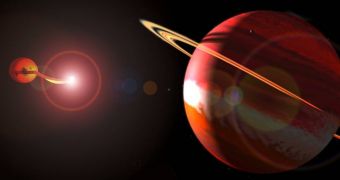In a unique discovery, researchers managed to identify a pair of extrasolar planets locked in a dance around each other. While this is not remarkable in itself, it becomes so when taking into account the fact that the system orbits a pair of stars, which are themselves locked in a binary system.
The two planets are both giants, early results of the observations indicate. If other telescopes confirm the discovery, then this would represent the first time that such a peculiar planetary system is found.
Thus far, astronomers have discovered more than 550 exoplanets, and are currently browsing through 1,235 more candidates. The latter were discovered by the NASA Kepler Telescope, a planet-hunter.
Even with all these findings, experts cannot identify more than a handful of planets orbiting binary star systems. What the new discovery does is create a new class of systems by itself. The two stars are not the same, but of different types.
One of them is a white dwarf – the helium-burning remnant of a Sun-sized star that reached the end of its burning cycle, exhausting its hydrogen fuel supplies – while the other one is a red dwarf. Both are smaller than the Sun in mass and size.
Experts in charge of the new study say that the two stars are so close to each other that they take only a few hours to complete a single orbit. Statistically speaking, the binary system would neatly fit inside our Sun, their orbits included.
But when Drs. Stephen Potter and Encarni Romero-Colmenero used the South African Astronomical Observatory (SAAO) to image the binary star, they noticed that the period of time it took one to eclipse the other as seen from Earth did not match theoretical calculations.
Sometimes, the eclipses occurred ahead of time, while other times they were delayed. The team therefore proposes that two gas giants exist in orbit around the stars. Locked in a binary system as well, these plants tug on the stars, interfering with their natural, mutual eclipse pattern.
The two exoplanets weigh in at 6 and 8 Jupiter masses, respectively, and take 16 and 5 years, respectively, to orbit the binary star system. The two experts say that there is no chance this star system is inhabitable.
The white dwarf continuously siphons matter from the red dwarf. The steady stream of particles is crashing into its surface, and gets heated up to tremendous temperatures, producing vast amounts of X-rays.
These radiations spread out through the star system, battering the two planets with deadly amounts of X-rays that no organism we know of could survive.

 14 DAY TRIAL //
14 DAY TRIAL //